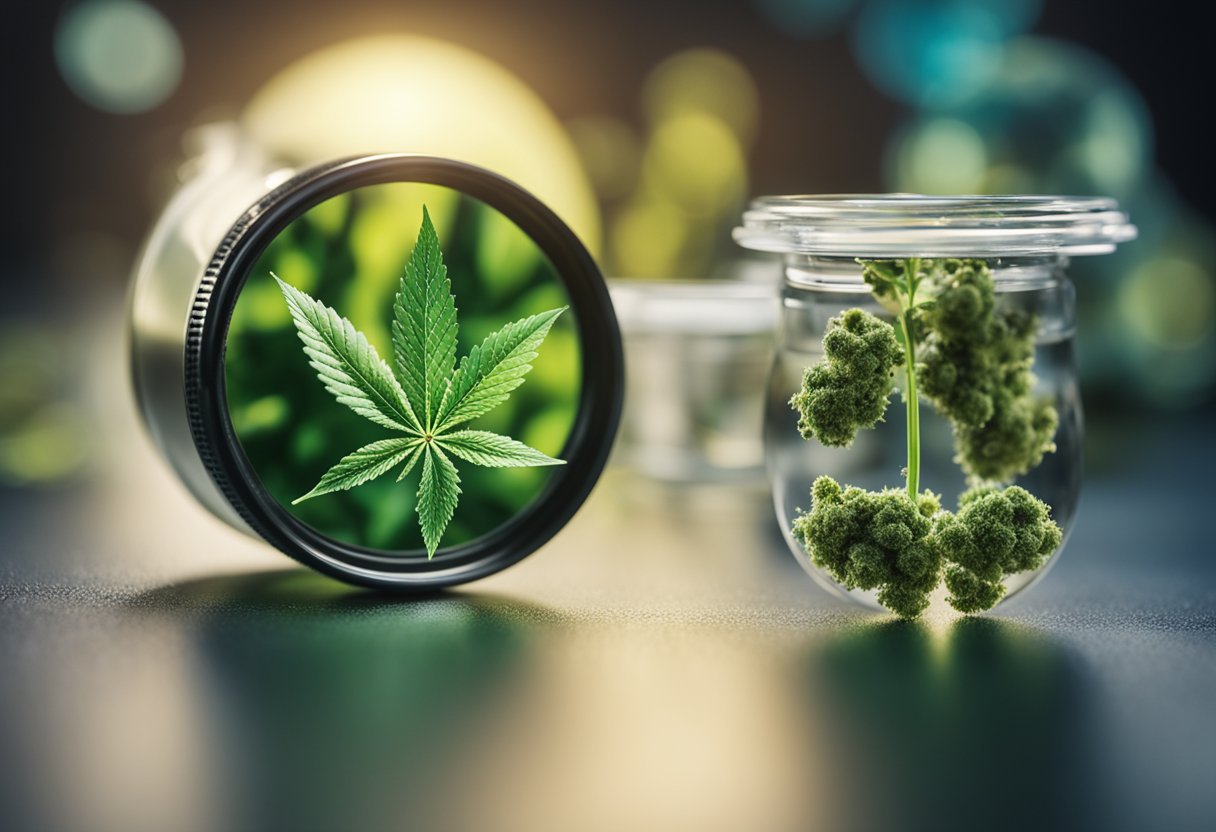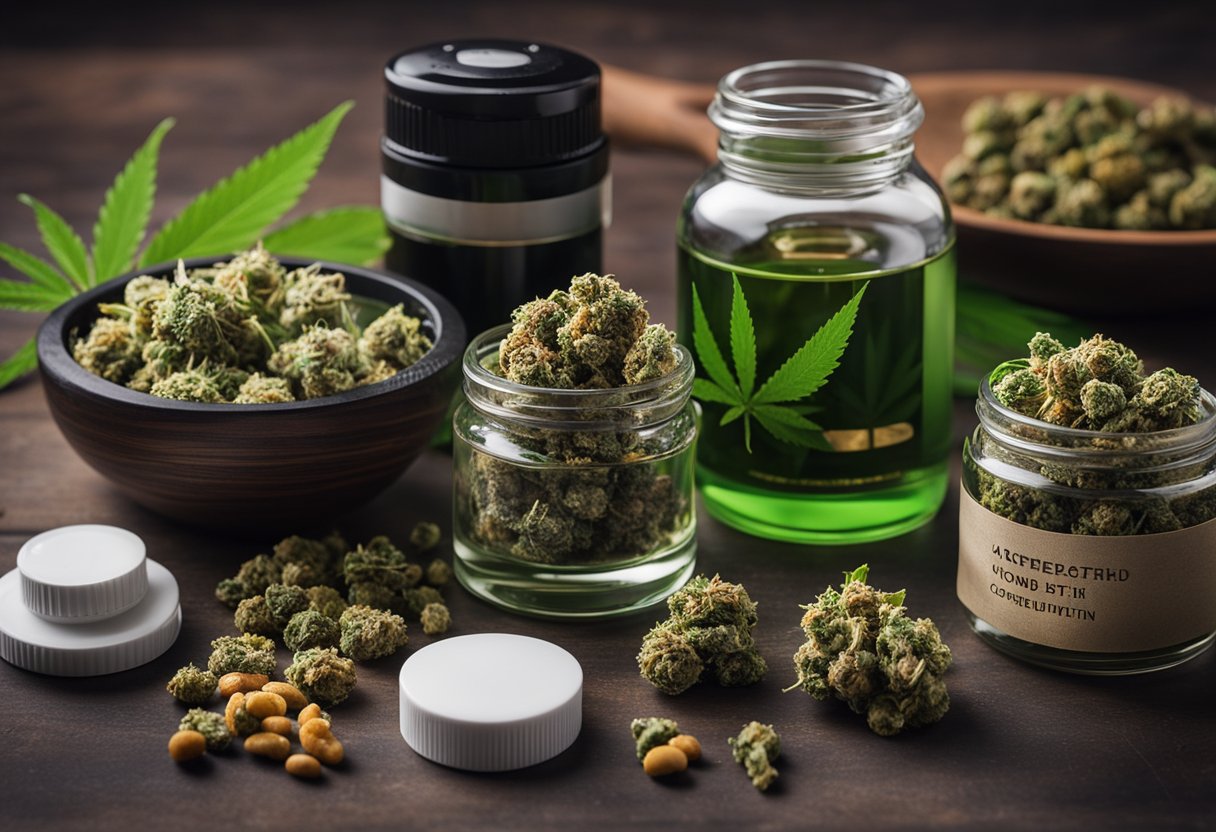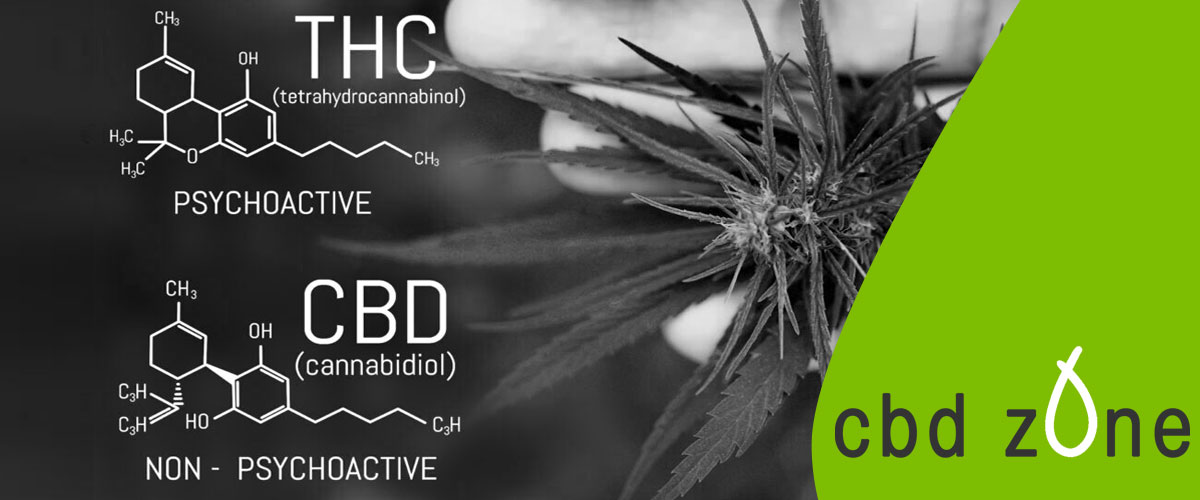The world of cannabis can be confusing for both newcomers and long-time users alike. With the growing popularity of medicinal and recreational cannabis use, it is important to understand the differences between the two primary compounds found in the plant: THC and CBD. These compounds are not only responsible for the various effects cannabis has on the body, but also play a significant role in the medicinal applications of the plant.

THC, or tetrahydrocannabinol, is the psychoactive compound found in cannabis that is responsible for the “high” sensation experienced by users. On the other hand, CBD, or cannabidiol, is a non-psychoactive compound known for its potential therapeutic benefits. As interest in the health implications of these compounds has increased, so too has the need for a clear understanding of the distinctions between them and their respective applications.
The legal status and federal regulations surrounding these compounds can differ, with CBD often touted as the “safe” option in comparison to the more heavily regulated THC. As consumption methods and cannabis products continue to diversify, understanding how these compounds interact with the body through the endocannabinoid system becomes essential for consumers and medical professionals alike.
Highlights
- Understanding the differences between THC and CBD is crucial for cannabis users
- The legal status of these compounds varies, with CBD often being less heavily regulated
- Knowledge of consumption methods and the endocannabinoid system is essential for informed use
Chemical Profiles of THC and CBD
Cannabinoid Structure and Concentration
Cannabinoids, like tetrahydrocannabinol (THC) and cannabidiol (CBD), are naturally occurring compounds found in the cannabis plant. They have distinct molecular structures, which influence their effects on the human body.
- THC: C₂₁H₃₀O₂
- CBD: C₂₁H₃₀O₂
Although their chemical formulas are actually the same, the difference in their molecular structure is responsible for their varying effects.
THC’s Psychoactive Properties
THC is the primary psychoactive component of cannabis, which creates the feeling of being “high” that many users experience. This effect can be attributed to its molecular structure. When consumed, THC binds with the cannabinoid type 1 (CB1) receptors in the brain, resulting in the psychoactive effect.
Some potential effects of THC include:
- Euphoria
- Relaxation
- Enhanced senses (taste, smell, sound)
- Altered perception of time
- Short-term memory loss
It is important to note that people’s experiences with THC can vary, as it depends on the individual’s body chemistry and dosage.
CBD’s Non-Intoxicating Effects
Unlike THC, CBD does not produce a psychoactive effect. This makes it a popular choice for people seeking the potential therapeutic benefits of cannabis without the “high.” CBD’s molecular structure prevents it from binding to the CB1 receptors in the brain, which is why it does not create a psychoactive experience.
Some potential benefits of CBD include:
- Pain relief
- Anti-inflammatory properties
- Reduction of anxiety
- Antipsychotic effects
- Improvements in sleep quality
As with THC, the effects of CBD can vary between individuals, and more research is needed to fully understand its therapeutic potential.
In conclusion, THC and CBD are both cannabinoids found in the cannabis plant, but their differing molecular structures result in unique effects on the human body. While THC is known for its psychoactive properties, CBD is non-intoxicating and sought after for its potential therapeutic benefits.
Legal Status and Federal Regulations
Cannabis Legalization in Canada
In 2018, Canada legalized the recreational use of cannabis nationwide, becoming the second country to do so after Uruguay. The Cannabis Act regulates the production, distribution, sale, and possession of cannabis across the country. Adults aged 18 or 19 (depending on the province) and older are allowed to possess up to 30 grams of dried cannabis and cultivate up to four plants per household.
THC vs. CBD Under Federal Law
Both THC and CBD are derivatives of the cannabis plant, but their legal statuses differ under Canadian federal law. THC is the psychoactive compound responsible for the “high” associated with cannabis use, while CBD is non-psychoactive and primarily associated with potential health benefits.
In Canada, CBD falls under the same legal framework as THC due to its classification as a cannabinoid. Thus, CBD is also regulated under the Cannabis Act, and its production, distribution, and sale must adhere to strict guidelines. However, the focus of regulations is primarily on products containing THC, as those pose a greater risk for abuse and dependence.
Controlled Substances Act: Prior to the Cannabis Act, cannabis and its derivatives, including THC and CBD, were regulated under the Controlled Substances Act. This legislation classified cannabis as a Schedule II drug, indicating a high potential for abuse and addiction. With the 2018 legalization, the scheduling of cannabis derivatives is no longer applicable, and the Cannabis Act now governs their production and use.
Industrial Hemp and Farm Bill
Apart from the cannabis plant, CBD can also be derived from industrial hemp, a variety of the Cannabis sativa plant species that contains negligible amounts of THC (< 0.3%). This distinction is significant because it places the production of industrial hemp under a different legal framework.
The Industrial Hemp Regulations, which fall under the Cannabis Act, allow licensed producers to grow, process, and sell industrial hemp for various purposes, such as producing fibre and CBD. These regulations also mandate that industrial hemp must contain less than 0.3% THC, ensuring that hemp-derived CBD products have no psychoactive effects.
In summary, Canadian federal law regulates cannabis, THC, and CBD under the Cannabis Act, whereas the Industrial Hemp Regulations pertain to non-psychoactive industrial hemp. These legal frameworks provide guidelines for the production, distribution, and sale of these substances, as well as establish minimum age requirements for their possession and usage.
Medical Applications and Health Effects
When comparing THC and CBD, it is important to consider their various medical applications and health effects. Both compounds have been shown to have potential health benefits, but they also differ in their therapeutic uses and potential side effects.
Therapeutic Uses of CBD
CBD is known for its non-psychoactive properties and potential health benefits. Some of its potential therapeutic uses include:
- Anxiety: Studies have shown that CBD may help reduce anxiety and improve overall mental well-being.
- Pain and inflammation: CBD has been shown to have anti-inflammatory properties and may help reduce pain and discomfort in various conditions.
- Epilepsy: Several research studies have demonstrated that CBD can effectively reduce the frequency and severity of seizures in people with epilepsy.
- Neuroprotection: CBD has shown potential for promoting brain health and protection against neurodegenerative diseases.
Medical Cannabis Containing THC
While CBD offers therapeutic benefits without the psychoactive effects, medical cannabis containing THC may be beneficial in treating certain conditions. Some medical applications of THC include:
- Nausea and vomiting: THC has been found to be effective in reducing nausea and vomiting caused by chemotherapy treatments for cancer patients.
- Pain relief: Medical cannabis containing THC has been used to alleviate pain in various conditions, including neuropathic pain and cancer-related pain.
- Appetite stimulation: THC has been shown to help stimulate appetite in patients with chronic illnesses, such as HIV/AIDS and cancer.
Potential Side Effects and Risks
Despite the potential health benefits of CBD and THC, there are some possible risks and side effects to consider:
| Compound | Possible Side Effects |
| CBD | Diarrhea, fatigue, changes in appetite, and potential interactions with medications. |
| THC | Dizziness, dry mouth, increased heart rate, lowered blood pressure, and impaired short-term memory. |
It is crucial to consult with a doctor before using medical cannabis or CBD products for therapeutic purposes. A physician can provide guidance on appropriate dosages and potential side effects based on individual needs and medical history.
Consumption Methods and Cannabis Products

When it comes to THC and CBD, there are various consumption methods and products available. This section will explore three major categories, including oils, edibles, and tinctures, as well as prescription drugs and synthetics.
Oils, Edibles, and Tinctures
Oils are one popular way to consume cannabinoids like THC and CBD. They can be applied under the tongue, added to food or drinks, or even used topically. Two popular types of oils include:
- CBD oil: Often used for its potential therapeutic benefits, such as helping with anxiety or pain relief.
- THC oil: Provides the psychoactive effects associated with marijuana that many recreational users find enjoyable.
Edibles offer a discreet and long-lasting method for consuming THC or CBD. Some popular edible options are:
- Gummies: These soft, chewable candies come in various flavours and can contain either THC or CBD.
- Baked goods: Brownies, cookies, and other baked products may be infused with THC or CBD.
- Beverages: From cannabis-infused teas to sodas, these drinks can help users consume THC or CBD in a refreshing way.
Tinctures are liquid extracts that can be taken under the tongue or added to food and drinks. They come in various strengths and are often used for their precise dosing. The most common types of tinctures are:
- Full-spectrum tinctures: Contain a combination of cannabinoids, including both THC and CBD.
- CBD-only tinctures: Made with isolated CBD and no THC, offering potential therapeutic benefits without causing intoxication.
Prescription Drugs and Synthetics
For patients who require more traditional medical options, there are several prescription drugs and synthetic cannabinoids available. Here are a few examples:
- Epidiolex: This is a CBD-based medication that has been approved to treat certain forms of epilepsy in children.
- Dronabinol (Marinol): A synthetic THC medication used to treat nausea and vomiting in chemotherapy patients, and to stimulate appetite in individuals with HIV/AIDS.
- Nabilone (Cesamet): A synthetic cannabinoid that works similarly to THC, used to treat nausea and vomiting in cancer patients undergoing chemotherapy.
These drugs come as oral solutions or capsules, providing patients with a convenient and regulated way to obtain the therapeutic effects of THC or CBD.
Cannabinoid Receptors and the Endocannabinoid System
The endocannabinoid system (ECS) is a complex cell-signaling system found throughout the human body. It plays a crucial role in regulating various physiological processes, such as sleep, appetite, and mood. This system is composed of three main components: endocannabinoids, receptors and enzymes.
Role of the ECS in the Human Body
The primary function of the ECS is to maintain homeostasis, or balance, within the body. It accomplishes this through the production of natural cannabinoids called endocannabinoids. These endocannabinoids bind to cannabinoid receptors found throughout the nervous system and other parts of the body, leading to specific outcomes based on which receptors they bind to.
The ECS has been linked to countless functions, including:
- Sleep regulation
- Appetite control
- Mood and stress management
- Inflammation management
- Immune system response
- Pain perception
Given the system’s involvement in so many crucial processes, it’s no surprise that the ECS and its receptors have become an area of interest for those studying cannabis and its potential medicinal benefits.
Effects on CB1 and CB2 Receptors
There are two primary types of cannabinoid receptors within the ECS: CB1 and CB2 receptors. These receptors are affected by both natural endocannabinoids produced within the body and external cannabinoids, such as those found in Cannabis sativa, the hemp plant.
| Receptor | Location | Function |
| CB1 | Primarily in the brain and central nervous system (CNS) | Regulates various neurological functions (e.g., mood, appetite, and sleep) |
| CB2 | Immune cells and peripheral organs | Modulates immune response and inflammation |
CB1 receptors are primarily responsible for the psychoactive effects of cannabis, as they are the primary target for tetrahydrocannabinol (THC), the main psychoactive component in cannabis. When THC binds to these receptors, it alters communication between neurotransmitters, which results in the “high” users experience.
Conversely, CB2 receptors are targeted by cannabidiol (CBD), a non-psychoactive component of cannabis, which does not produce a high. Instead, CBD interacts with CB2 receptors to provide potential therapeutic benefits, such as reduced inflammation and pain relief.
Understanding the relationship between the ECS, cannabinoid receptors, and external cannabinoids like THC and CBD is crucial in exploring the potential benefits of cannabis for various medical conditions and overall health.
Frequently Asked Questions
What are the legal considerations for possessing CBD oil containing THC in Canada?
In Canada, the Cannabis Act regulates the legal production, sale, and possession of cannabis products, which includes both THC and CBD. As of October 17, 2018, industrial hemp-derived CBD oil containing less than 0.3% THC is legal to purchase and possess, without a prescription. However, CBD oil derived from cannabis plants with a higher THC content may require a medical prescription.
How do the effects of THC gummies compare to those of CBD gummies?
THC gummies contain the psychoactive compound found in cannabis that can produce a euphoric high, which affects mood, cognition, and perception. On the other hand, CBD gummies do not produce a high. They contain CBD, a non-psychoactive compound that provides potential therapeutic benefits, such as anti-inflammatory and analgesic properties, without altering the user’s mental state.
What are the distinct impacts of THC oil on the body?
THC oil primarily interacts with the body’s endocannabinoid system. It binds to the CB1 receptors found mainly in the brain and nervous system, inducing psychoactive effects, such as euphoria, relaxation, and heightened sensory perceptions. Other effects can include increased heart rate, dry mouth, and red eyes. On rare occasions, high doses of THC oil may cause anxiety, paranoia, or hallucinations.
Who might need to abstain from using CBD products?
Although CBD is generally considered safe and well-tolerated, some individuals should consult with their healthcare provider before using CBD products. These include pregnant and breastfeeding women, individuals taking certain medications, and those with liver disease or other serious health conditions. Additionally, anyone with a known allergy to cannabis should avoid CBD products derived from cannabis plants.
Can users experience a sensation of feeling spaced out after taking CBD?
CBD is a non-psychoactive compound, which means it does not produce a high or alter the user’s mental state. However, some individuals may experience mild side effects, such as drowsiness or lightheadedness after taking CBD, depending on the dosage and individual sensitivity. Monitoring one’s reaction and adjusting the dosage accordingly can help to reduce or eliminate these sensations.
Is CBD still beneficial in the absence of THC?
Yes, CBD can still provide potential health benefits without the presence of THC. While some studies suggest that the combination of CBD and THC might have a synergistic effect known as the “entourage effect,” CBD on its own has been shown to possess numerous therapeutic properties, such as anti-inflammatory, analgesic, and antianxiety effects. This makes CBD an attractive option for those who do not desire the psychoactive effects of THC.

